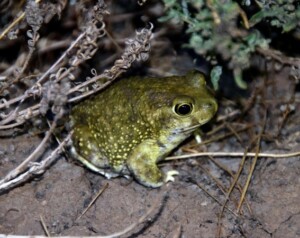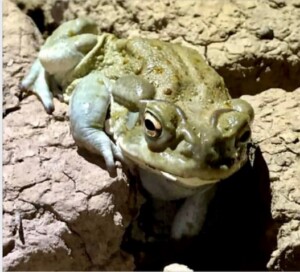LONG-TERM AMPHIBIAN MONITORING
Why It Matters
Amphibians in the desert? Yes, indeed! Despite the many challenges presented by arid systems, frogs, toads, and salamanders have developed adaptations that allow them to thrive in desert systems. These animals are important parts of both healthy ecosystems and food webs. Because of their highly permeable skin that easily absorbs toxins, they are also excellent indicators of environmental health, both on land and in water.1
Yet, globally, 42% of amphibian species are threatened due to habitat loss and degradation, pollution, disease, invasive species, use and trade, and climate change.2 Within this group, amphibians with narrow ranges and whose larvae develop on land or moving water are most sensitive to habitat modification.3
Monitoring for amphibians is essential for protecting those species, as well as to protect important water sources, monitor ecosystem health, and be proactive in management decisions.
The Conservancy’s Work
Scottsdale’s McDowell Sonoran Preserve houses few constant water sources and several fleeting sources, which provide vital sources of drinking water for animals and refugia for toads. One of these temporary sites is in an area that receives heavy recreation pressure (despite it being off-trail) and is experiencing drastic change as new housing developments are being constructed nearby. Because of this area’s importance and easy accessibility, in 2016, the Conservancy began annual surveys during the rainy season to document species presence and relative abundance. In 2019, just prior to construction increasing in the surrounding area, these efforts increased to include weekly monitoring from July through September to assess species phenology (timing of emergence, reproduction, metamorphosis, and retreat into hibernacula) in relation to water availability.
These data help assess how natural factors (such as precipitation and water availability) and anthropogenic influences (such as development and recreation) affect species, including persistence of amphibians at this important site. If population declines or substantial shifts in timing of life stages are observed, conservation solutions can be implemented.
What’s Been Found
The Conservancy has documented four species of toads at this site: Great Plains toad (Anaxyrus cognatus), red-spotted toad (Anaxyrus punctatus), Couch’s spadefoot (Scaphiopus couchii), and Sonoran Desert toad (Incilius alvarius). Despite well below average monsoon precipitation during 2019 and 2020, toads were observed during both years, even when there was no standing water.
The Conservancy has also detected differences in the phenology of the four species, with Great Plains toad being present even with no precipitation; Couch’s spadefoot and Sonoran Desert toads being present with adequate rainfall, even without standing water; and red-spotted toads only appearing with standing water (this species was not observed in 2019 or 2020 but was observed in previous years).
Despite the area being closed to the public, it continues to receive heavy recreational pressure, which can affect toads and other wildlife. In response, the City of Scottsdale installed signs at access points reminding the public that the area is closed to protect sensitive habitat.
How You Can Help
Tracking biodiversity trends is one of the best ways we can protect Sonoran Desert species and their habitats. That’s why we need your support. You can ensure the desert will continue to thrive and be a place to enjoy for all, now and for future generations to come. Document any amphibians you see and help scientists better understand their distribution on iNaturalist.
- Learn more about amphibians in Arizona from the Arizona Game and Fish Department.
- Do not handle wild amphibians and avoid areas where they are likely to occur
- Follow guidance by Endangered Species International
- Avoid chemical use by eating organic food and not using pesticides
- Protect amphibians from pets
- Leave native aquatic vegetation growing in your pond
- Support McDowell Sonoran Conservancy with a gift or volunteer as a Steward
McDowell Sonoran Conservancy Contact:
Jessie Dwyer | 480-998-7971 ext. 104 | jessie@mcdowellsonoran.org
15300 North 90th Street, Suite 400, Scottsdale, Arizona, 85260 | 480-998-7971

Literature cited:
- Burlibaşa, L. & Gavrilacaron;, L. Amphibians as model organisms for study environmental genotoxicity. Ecol. Environ. Res. 9, 1–15 (2011).
- IUCN – SSC Amphibian Specialist Group. (2020). Available at: https://www.iucn-amphibians.org. (Accessed: 10th June 2020)
- Nowakowski, A. J., Thompson, M. E., Donnelly, M. A. & Todd, B. D. Amphibian sensitivity to habitat modification is associated with population trends and species traits. Ecol. Biogeogr. 26, 700–712 (2017).
DISCOVER MORE
Protect Your Sonoran Preserve
The Power to Sustain the Sonoran Desert for Future Generations is Yours

